
16 minute read
A NEW SPIN ON HOTEL FITNESS
As the demand for wellness travel grows, so cycling is surging forward as a key component of hotel-based fitness. Kate Cracknell reports
Cast your mind back as little as 10 years to your experience of hotel gyms. Chances are, even at the most luxurious destinations, your work out took place in a small box of a room that housed perhaps a couple of treadmills, a Swiss ball if you were lucky, and a few dumbbells. It was there, the hotel gym, but it was an after thought. Provision without passion. Something that was neither seen to contribute positively to the brand if done well, nor to undermine it if done half-heartedly. A tick in the box for the small minority of guests who wanted to work out, but no wow factor.
Fast-forward to today and all that has changed, with hotels around the world investing significant sums in fitness and wellbeing facilities that deliver the experiences travellers are now look ing for – namely, experiences that are at least as good as the ones they’re used to back home.
A resounding 83 per cent of business travellers now consider the gyms and wellbeing activities on offer before selecting a hotel – this according to travel management company CWT. Wellness tourism is also on the rise, growing by 6.5 per cent annually between 2015 and 2017 and pro jected to reach US$919bn by 2022. That growth is more than twice as fast as tourism overall (3.2 per cent annually, according to Euromonitor data).
The situation is summed up perfectly in the foreword of a December 2019 report – It’s a Wellness World – by hotel brand Accor, in which Emlyn Brown, vice president of wellbe ing luxury & premium brands, explains: “The data shows we need to make wellness the standard, not the add-on. And we need to think bigger: beyond the gym, beyond the spa, and beyond granola and chia seeds for breakfast.”
It is, he says, about integrating feeling bet ter into the entire customer journey, allowing guests to maintain their healthy habits as well as helping them discover new ones. “Because the modern luxury traveller of now – and the future – is on a journey: to find purposeful new travel experiences that speak to their inner self and to personal fulfilment. And they’re willing to pay a premium for it.”

+ With hundreds of virtual classes on offer, BODY BIKE's new SMART+ SWITCH is ideal for hotel gyms, as well as in-room fitness
Indeed, Global Wellness Institute data indi cates that wellness travellers’ spend per trip is 53 per cent higher than the average tourist on international trips, and 178 per cent higher on domestic trips. Not only that, but as Brown ex plains: “The data shows that how well we meet their wellness needs influences how ‘delighted’ they feel about their hotel stay, and how likely they are to return.”
“No longer a trend, no longer an option. No longer a commitment just at home, or in waking hours; wellness is the standard our guests have come to expect,” adds François Dung, senior VP con sumer & market insights, in a second foreword.
The question today is not: ‘Will you invest in your wellbeing provision?’ It’s: ‘How much, and what will be your model?’, with a number of different options to be considered.
The full-service club
In-hotel membership-based health clubs are nothing new; the likes of Village Hotels in the UK, and Hilton’s LivingWell, have been operating successfully for years. And to Ride High’s specific agenda, both feature good quality group cycling; Village even offers Les Mills’ immersive cycling experience THE TRIP at four of its clubs, as well as both virtual and live instructor-led classes at the majority of the other 30+ sites where it partners with Les Mills. Meanwhile, Technogym lists a number of hotels among its clients, all offering live classes to both guests and members. And even smaller hotels, such as those owned by the Soho House group, have recognised the appeal of group cycling: in the UK, Shoreditch House has a dedicated studio offering 31 House Ride classes each week.
But while hotel-based membership clubs aren’t new news, we’re certainly witnessing a momentum towards more expansive in-hotel fitness and wellbeing, financed at least in part by a local membership base. “Hotels increasingly see themselves as wellness destinations,” observes Matt Laird, global projects director for Resense. Jeremy McCarthy, group director of spa & wellness for Mandarin Oriental Hotel Group, confirms: “We see our future development trending towards larger, membership-orientated health clubs. These will include group cycling: our new projects in Moscow, Boca Raton, Dubai, Nanjing and Dallas all feature cycling in their plans.”
Meanwhile, Resense is working with Kempins ki to open a new hotel in Bangkok in April/May 2020, where a boutique gym is set to cater for around 500 members – alongside hotel guests – in a way that will see it compete strongly against local health club competition. Its five studios will include a dedicated cycling studio with IC7 bikes and a big screen, offering both live and virtual classes. “It’s basically a collection of luxury boutiques in a big box, which hotel guests can access for free but with constant membership revenue charged at just a bit above other local high-end clubs,” explains Laird.
Paul Bowman, CEO of Wexer, adds: “Hotels are in an excellent position, as they already have great locations – cue cycling classes with views across the beach or city skyline, for example. As in-house health clubs get even better, not only do hotels get to sweat the asset by selling mem berships, but the gym becomes a new business driver for the hotel in much the same way as restaurants have been for a while now: locals become brand ambassadors, recommending the hotel – off the back of their restaurant and/ or health club experiences – to guests coming in from out of town.”

+ Opening soon, the new Kempinski hotel in Bangkok will feature a dedicated cycle studio
The club/hotel hybrid
As the bar of in-hotel fitness provision continues to be raised, says Laird: “Some of the bigger hotel brands are looking to cast themselves as ‘global Equinoxes’.”
But the flip side is also true, with some of the bigger fitness and wellbeing brands ventur ing into hospitality. In fact, in Europe, Aspria has done this for many years: half of its clubs include on-site hotels, with discounted rates for members, and hotel guests enjoying access to the full wellbeing offering: spa, fitness, sport, restaurants and more.
But this trend has certainly gone up a gear re cently, not least thanks to the brand power and visibility that Equinox brings to its new ventures. In summer 2019, it opened its long-awaited wellness hotel in New York’s Hudson Yards; ho tels in Los Angeles, Santa Clara, Seattle, Chicago and Houston are set to follow.
At the Equinox Hotel Hudson Yards, 212 guest rooms are complemented by a 60,000sq ft Equinox health club – at the time of opening, the largest Equinox gym in the world – as well as a 27,000sq ft (2,500sq m) luxury spa, indoor and outdoor pools, a SoulCycle studio and a healthy-eating restaurant. All hotel guests are given temporary Equinox membership for the duration of their stay.

+ In the UK, Village Hotels offers Les Mills’ THE TRIP at a number of its on-site clubs
Midtown Athletic Clubs is another brand that’s thrown its hat into the hospitality ring, with the September 2017 opening of its Chicago club, a boutique hotel (55 rooms and four suites) built right at its heart.
As at Equinox, you’re a member of the Mid town club for as long as you stay at the hotel. That includes all group exercise, for which the club is rightly famous, its five distinct GX areas in effect in-club boutiques. The Field’s huge ex panse of turf is an inspirational space for functional training classes; Samadhi is a stunning yoga studio complete with wide wooden floor boards and two beautifully crafted trees; Ev eryBody Fights is a dark, moody space dedicated to George Foreman III’s boxing programme; The Theater is all lights, camera, action for group fitness; and RIDE is a 55-bike cycling studio, complete with giant screen projecting immersive, rock concert-quality visuals.
There are almost 300 classes on the Midtown Chicago timetable, of which 56 are RIDE – a popular option that averages around 80 per cent capacity, with many classes full. How ever, as the club does not operate a booking system for any classes, hotel guests are not at a disadvantage compared to members. “If you have a booking system, you need some sort of penalty system for no-shows too, and that doesn’t sit well when people are paying US$200–250 a month,” explains Midtown president Jon Brady.
‘Alone Together’
Midtown is now in the process of building hotels as part of club renovations in upstate New York and another Chicago location, and is looking at further options in both existing and new clubs. And Brady sees other operators following suit: “As a general rule, hotel operators won’t be experts in fitness, and vice versa, but we will see more experimentation as those who have taken a leap of faith, like Midtown, are succeeding.”
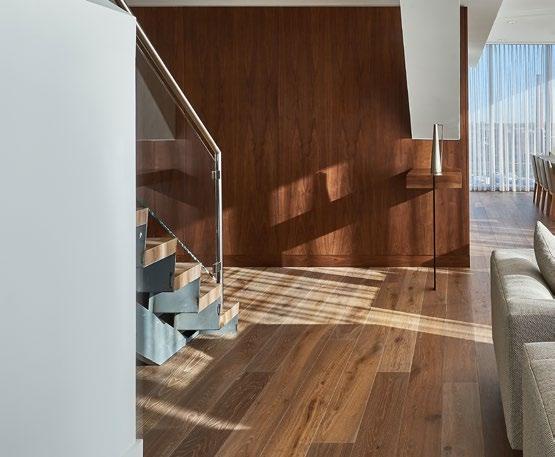
+ Midtown Chicago allows guests at its hotel to (this picture) access all classes in its boutique-style spaces (pictures below)
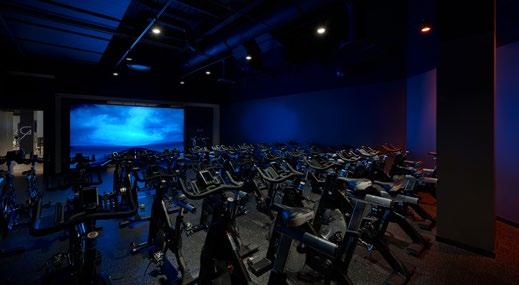
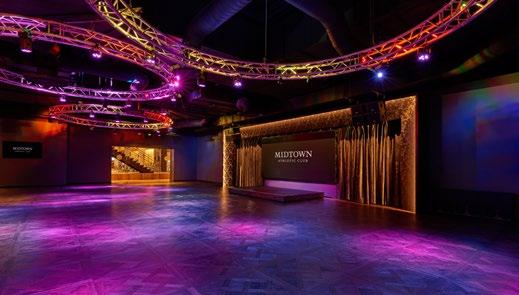

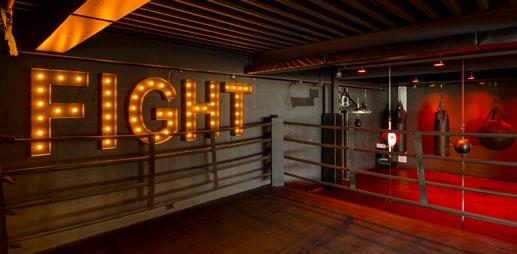
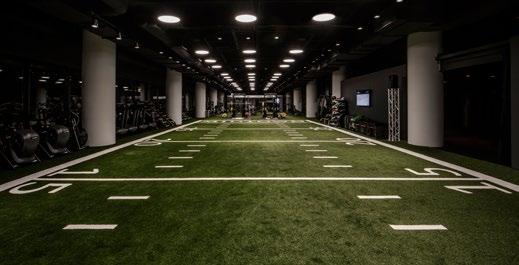
He continues: “Ours is a 675,000sq ft health club with a hotel attached, as opposed to a huge ho tel with smaller gym or in-room fitness. That’s an important difference, because it helps us cre ate the experiences that guests want.
“At Midtown, we call it ‘Alone Together’, and it’s all about the fact that people like to be around other people, even if they aren’t engaging with them. It’s why hotel bars are so popular. You could have exactly the same drink in your room, but you’d rather be around people than looking at your four walls. Our clubs therefore have spaces where you can just sit and work, or have a coffee or a glass of wine, with others around you.
“People are looking for that same sense of community and connection when they work out. It’s missing from an in-room exercise ex - perience, but it’s something health clubs are perfectly placed to deliver.”
In-room fitness
Yet there are brands that have made a success of in-room fitness, not least Hilton’s Five Feet to Fitness concept, which launched in 2017. With 11 different equipment and accessory options incorporated into the hotel room – including Wattbike as the cycling option – all support - ed by over 200 bespoke exercise tutorials via a touchscreen display, guests have everything they need for a workout at any time of the day or night. The concept is currently available in around 20 hotels, with plans to roll it out further.
Other hotel brands treading this same path in - clude EVEN Hotels, whose whole purpose is wellbeing and where the guest rooms double as gyms; Swissotel Vitality suites, where a Wellbe - ing Wall offers cables and weights alongside a Peloton bike and WaterRower; WestinWorkout rooms, which are equipped with either a bike or treadmill, plus pilates equipment; and Tryp by Wyndham’s Fitness Rooms, offering either bike, elliptical or treadmill plus yoga mat.
Meanwhile, at Accor’s Fairmont hotels, loyalty members can request yoga mats and other fitness equipment be delivered to their room. Laird comments: “I know of a few places that offer bikes on demand too, brought to your room on request.”
Mandarin Oriental’s McCarthy adds: “We find that fitness is increasingly important to our guests, but it’s also becoming more niche and person alised. Our approach is to strive to know our guests better, so we can deliver the specific fit ness experience that each guest is looking for in a personalised way. For runners, this might mean access to downloadable jogging maps on their fa vourite app. For yoga practitioners, we may offer a yoga mat and complimentary yoga videos they can follow in their room. And for cyclists, we usu ally offer some kind of studio cycling bike; some of our guests have even told us that the specific cycling set-up we were able to offer was a factor in choosing where they stayed.”
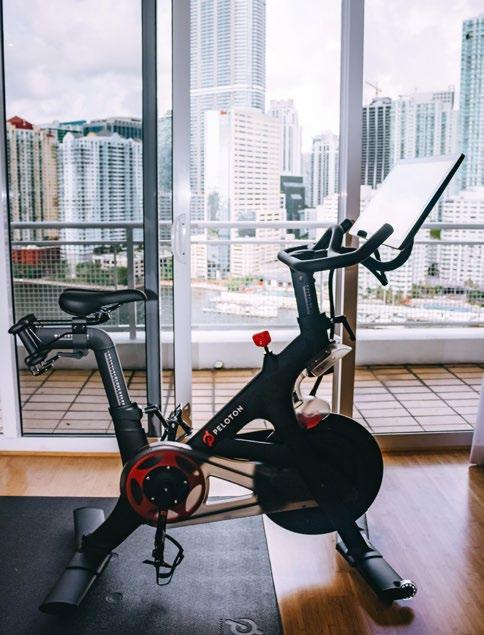
+ Mandarin Oriental Miami offers in-room Peloton bikes
Quick returns Certainly, with in-room workouts already the favoured option for 27 per cent of business travellers in spite of limited options at this stage – another interesting stat from CWT – the pure convenience of the set-up means we’re likely to see in-room fitness continue to grow, particularly as new technology emerges to make the experience ever-more engaging.
“In-room fitness is a big thing in the US, with customers really taking to this concept and hotel owners getting full ROI very quickly. Hilton is now expanding its concept internationally – to the UK, EMEA, APAC – and other brands will need to react,” confirms Wattbike’s Steve Marshall.
Peloton already offers a Hotel Finder website, where would-be guests can track down hotels that offer Peloton bikes – around 500 hotels in the US alone, at the time of writing. Technogym is, it says, working on a wellness suite solution for hotels – an in-room wellness experience comprising its Peloton-style Technogym Bike, Skilltools selection and streamed classes – and is already trialling its Technogym Bike in-room at the Radisson Mayfair. And brand new to the market is BODY BIKE’s SMART+ SWITCH, a specially designed indoor cycle with a unique twist: it can guide exercisers not just through a cycling class but through a full-body workout, making it the perfect option for independent in-room fitness.
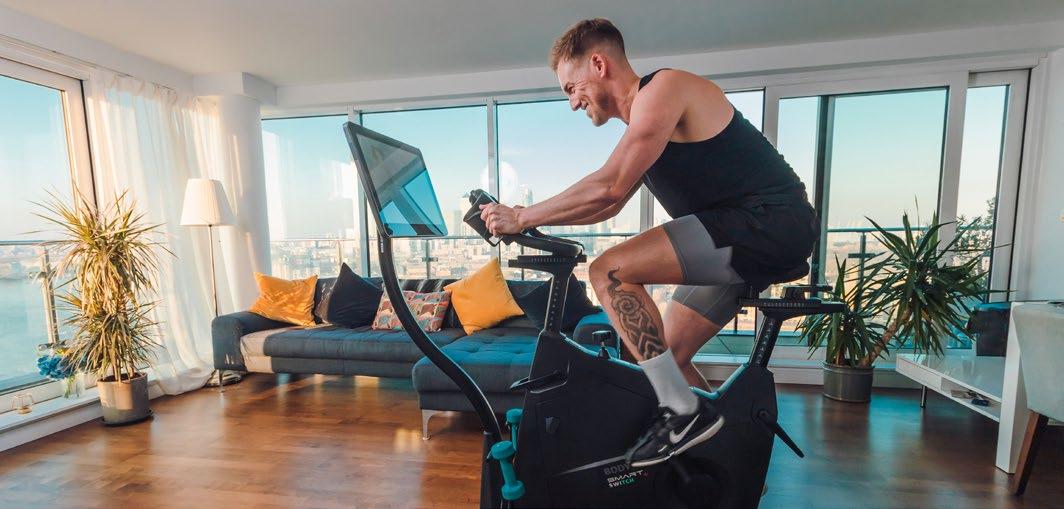
+ BODY BIKE SWITCH has a 180-degree rotating screen, allowing for virtual cycling and floor-based workouts
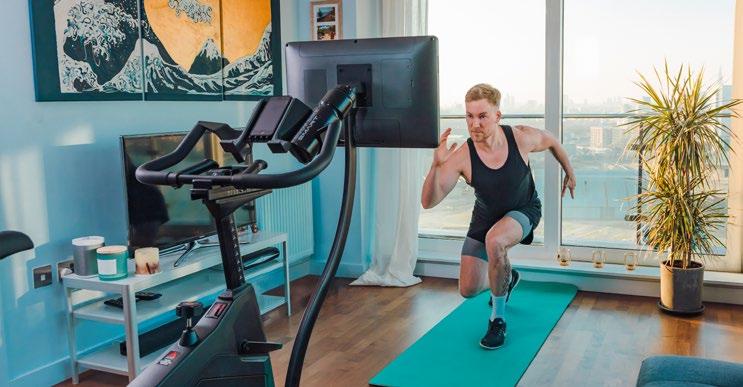
Created in collaboration with digital fitness market leader Wexer, SWITCH’s integrated screen comes pre-loaded with virtual class content for an uninterrupted, buffer-free experience. A further USP is the screen’s optional 180° swivel, meaning you can jump on, select a class and ride, then turn the screen around to com plete a floor-based workout in front of the bike: HIIT, cardio, strength, yoga, pilates, stretch or meditation, all requiring minimal equipment. All workouts are led by the top instructors in the world, with hotels offered the option to curate bespoke collections to suit their guests’ needs, choosing from over 500 classes – and growing – that span 12 languages.
Gym floor standalone
But where these bikes are making even more of an impact is on hotel gym floors, say the experts; Midtown is, it seems, onto something with its ‘Alone Together’ philosophy. “I was at the W Hotel and Omni Barton in Austin, Texas, the other day,” says Laird. “Both had gym floor Pelotons and all were being used. I predict we’ll see more and more virtual on the gym floor, and bikes are the obvious starting point: cycling is well established as a class format and easy to follow on a screen. Compared to other CV kit on the gym floor – cross-trainers, treadmills – it’s easier to have a screen on a bike and have people understand that they can jump on and do a virtual class.”

+ The W Hotel in Austin, Texas, offers Peloton bikes on its gym floor
He continues: “In the end, it’s all about content: getting group exercise into a hotel environment, at any time of day, with world-class instruction without the need for live instructors. Everyone is doing virtual these days, so consumers are used to it. And the level of instruction is better than you might normally get in a hotel, so it bet ter supports hotels’ premium positioning.”
Jon Canarick, managing director at North Castle Partners, the investor behind the Echelon bike, agrees: “Nowadays, a connected experience should be everywhere CV kit is.”
What matters, observes Laird, is having “bikes that last” – cue a whole raft of bikes coming onto the market that offer similar to Peloton but in a commercial model, where Peloton was always designed for home use. These new bikes include BODY BIKE SMART+ SWITCH – unique in its 180° flip screen option – alongside the likes of Freemotion’s CoachBike, the Technogym Bike, available now at Hilton Heathrow, and the Stages Les Mills Virtual bike, the latter already installed in hotels such as the NED and The Savoy in London. “The Stages Les Mills Virtual bikes are very popular with our guests, helping them keep up their fitness routines while trav elling, and feedback has been positive,” says Alison Vernon, director of rooms at The Savoy.
Echelon is also due to launch a commercial mod el in the near future, and Life Fitness recently added virtual content to all its CV kit.
Virtual studios
Other hotels have expanded their offering to create full Peloton studios, with the Sheraton New York Times Square and the 12,000sq ft gym at the TWA Hotel – in terminal 5 of New York’s JFK Airport – both great examples.
TWA Fitness caters for transit passengers, hotel guests and members drawn from the 400,000 employees working at JFK, and its 13-bike Pelo ton studio has been one of the most popular elements of the offering since it opened in mid2019. The studio is geared up for accessibility, so people can just turn up and jump on, but as Jay Wright – CEO and founder of The Wright Fit, which designed and now operates the gym – explains: “Our team partners closely with the hotel sales department and it’s not unusual for large conference groups to request an entire studio buy-out for two or three classes during their event.”
Meanwhile, Wexer says the demand tends to be for virtual GX spaces on hotel gym floors rather than separate studios, with its partners including Meliá, millennial-focused brand Selina, and Am sterdam’s Conservatorium Hotel. In a pilot, Meliá experienced a 10 per cent uplift in guest satis faction scores when it installed Wexer Virtual at two of its hotels, and as a result the operator has rolled out the offering to additional locations.
At its Paris Charles de Gaulle airport hotel, without any promotion on the part of the hotel, guests are selecting three to four on-demand cycling classes a day, with the bikes lined up in front of a big screen.
Les Mills is doing similar with its virtual product: at its Paris Bercy hotel, Accor Hotels’ Pullman brand has a gym floor virtual cycling space equipped with BODY BIKES and offering RPM and SPRINT classes. Meanwhile, Marriott features a number of hotels with Life Fitness bikes and Fitness on Demand classes.
Diverging models
“We’ll see more and more standalone virtual bikes on the gym floor, driven by the desire for world-class content and instruction that aligns with the hotel experience more broadly,” concludes Laird. “Complementing this will be some in-room access to bikes, perhaps on-demand. But mostly it will be about virtual workouts on the gym floor.”
“Simultaneously, we’ll see some brands move towards bigger wellness offerings, financed by local memberships, to better satisfy guests. These are quite likely to include cycling studios, for virtual classes and perhaps also live too.”
Marshall agrees: “Instructor-led indoor cycling classes will be important only in the largest sites. For the majority, we’re expecting customers to want to connect to a social group but to get that experience online.” The model for hotel-based fitness is diverging, then, but it seems cycling will remain at the heart of the offering.
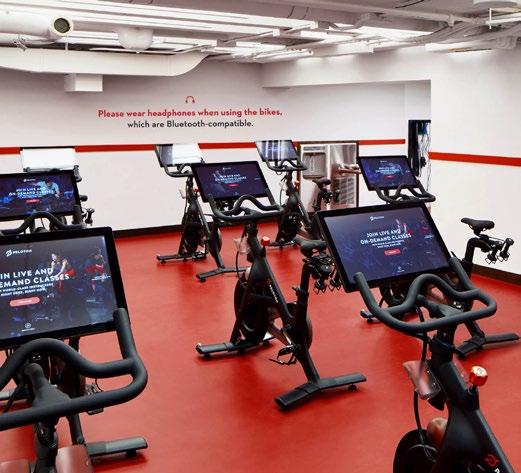
+ TWA Fitness - a 12,000 sq ft gym at TWA Hotel in New York's JFK airport - includes a peloton studio






